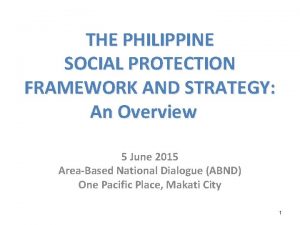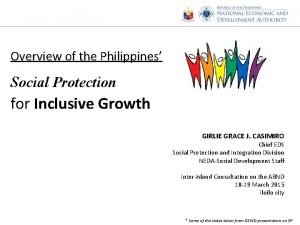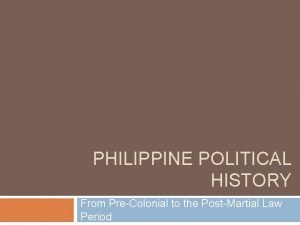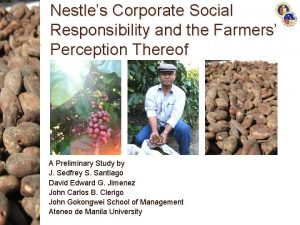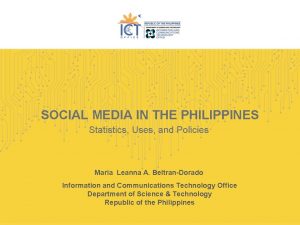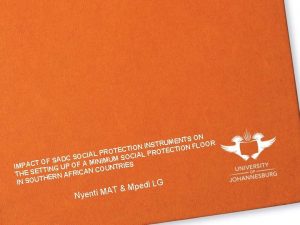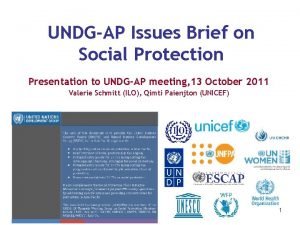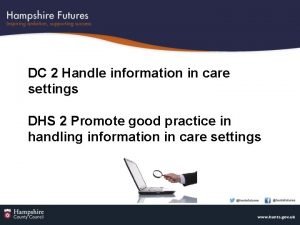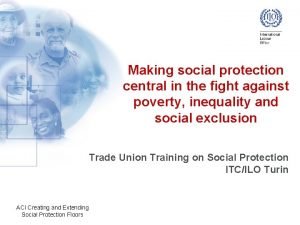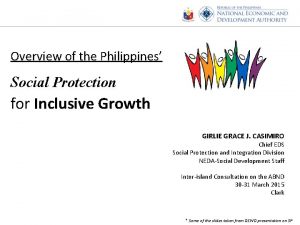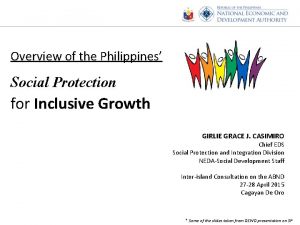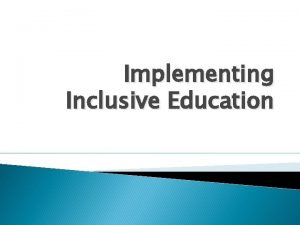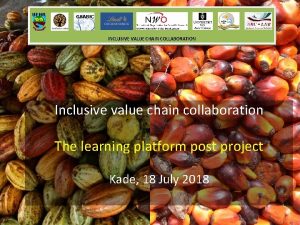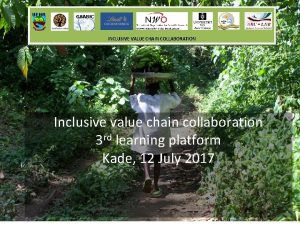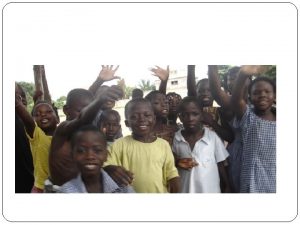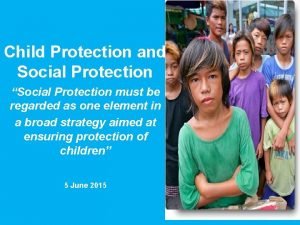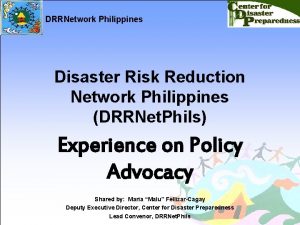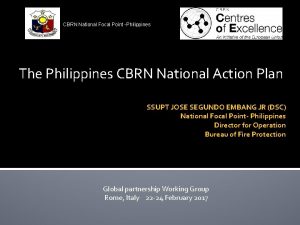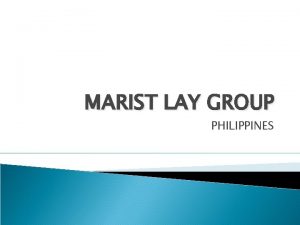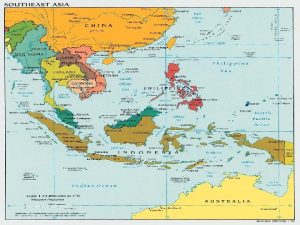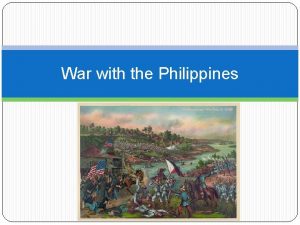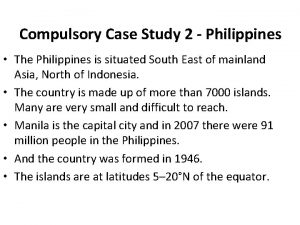Overview of the Philippines Social Protection for Inclusive



















- Slides: 19

Overview of the Philippines’ Social Protection for Inclusive Growth GIRLIE GRACE J. CASIMIRO Chief EDS Social Protection and Integration Division NEDA-Social Development Staff Inter-island Consultation on the ABND 18 -19 March 2015 Iloilo city * Some of the slides taken from DSWD presentation on SP

Outline of Presentation I. III. IV. V. Official Social Protection (SP) Definition Landmark Administrative Orders (AOs) NEDA Subcommittee on SP SP Operational Framework Where are we now?

Official SP Definition Social Protection constitutes policies and programs that seek to reduce poverty and vulnerability to risks and enhance the social status and rights of the marginalized by promoting and protecting livelihood and employment, protecting against hazards and sudden loss of income, and improving people’s capacity to manage risks.

Official SP Definition SP Components Labor market programs measures aimed at enhancing employment opportunities and protection of the rights and welfare of workers Social welfare preventive and developmental interventions that seek to support the minimum basic requirements of the poor

Official SP Definition Social insurance seeks to mitigate income risks by pooling resources and spreading risks across time and classes Social safety nets stop-gap mechanisms or urgent responses that address effects of shocks on specific vulnerable groups

Landmark AOs Administrative Order No. 232 (2008) – Social Welfare Reforms Administrative Order No. 232 -A (2008) – Further Strengthening the Clustering of Social Welfare Reforms into a National Social Welfare Program AOs gave way to the conduct of an assessment of social welfare and protection programs in the country --- "Review and Strengthening of the National Social Protection and Welfare Program“ by the Development Academy of the Philippines (DAP) depositphotos. com

NEDA SDC Subcommittee on Social Protection SDC Resolution no. 2, s. 2009 Chair: Undersecretary for Policy and Plans, DSWD Vice Chair: Deputy Director General for Policy and Planning, NEDA Members: NGAs: CHED, DAR, DBM, Dep. Ed, DOH, DILG, DOLE, DTI, GSIS, HUDCC, NAPC, NNC, PCFC, Phil. Health, SSS, TESDA, Leagues of Municipalities, Cities and Provinces NGOs: Social Watch Philippines and Pambansang Kalipunan ng mga Manggagawang Impormal sa Pilipinas (PATAMABA) Additional Attendees NSCB, NSO, NCIP, PCW Secretariat: DSWD – Policy Development and Planning Bureau Regional Level: Counterpart of the Subcommittee

NEDA SDC Subcommittee on Social Protection SDC Resolution no. 2, s. 2009 NEDA Social Devt Committee (NEDA-SDC) Human Devt. & Poverty Reduction Cluster (HDPRC) SDC Technical Board SDC Sub. Committee on SP SDC Sub. Committee 8

Social Protection Operational Framework Risk (or Shock) ü Uncertain event that may damage someone’s well-being leading to poverty ü Pervasive ü Mostly scarce information Poverty: ü Insufficient income or spending to ensure a minimum level or state of well-being ü Multidimensional

Social Protection Operational Framework Vulnerability ü Probability to become poor in the future ü Caused by risks, shocks and lack of physical, social and human capital to withstand shocks Vulnerability incidence higher than poverty incidence

Types of Social Risks and Vulnerabilities Social Risks Vulnerabilities Individual Life-cycle hunger, illness, disability, old age, death Economic unemployment, underemployment, low and irregular incomes; economic crises Environmental and Natural typhoons, drought, floods, earthquakes, volcanic eruption Political and Governance armed conflicts, crime, corruption, social exclusion and discrimination

Vulnerable Groups Affected by Major Social Risks Group or Sector Children: 0 – 5 years old 6 – 14 years old Risks and Vulnerabilities Illness and death, hunger and malnutrition, stunted growth Poor education quality Youth: 15 – 24 years old Low human capital, unemployment and underemployment, substance abuse Elderly: 65 years old and above Illness and death, low or lack of income Women Large family size, domestic violence, unemployment and underemployment People with disabilities (PWDs) Low human capital, unemployment and underemployment, lack of access to services Indigenous People Dislocation due to armed conflicts, natural disasters, development projects, lack of shelter and housing, access to water and sanitation Rural and Urban Informal Communities Dislocation due to armed conflicts, natural disasters and demolitions, lack of shelter and housing, access to water and sanitation

Social Protection Operational Framework

Where are we now?

Results and Strategic Framework for Social Development

SP Challenges ü Lack of a targeting mechanism that identifies the vulnerable, as well as the risks and shocks that they confront ü Need to strengthen capability of LGUs to implement disaster risk reduction strategies and deliver social protection services ü Limited number of poor and vulnerable beneficiaries despite nationwide implementation of programs and projects ü Increasing vulnerability of OFWs and migrant workers ü Limited social protection interventions for the following sectors: displaced and repatriated workers; informal sector; PWD; orphans; and IPs/ indigenous cultural communities.

Current Initiatives ü Roll-out of the SP Handbook to LGUs ü Inventory and review of SP programs and projects: - ABND for SP Floor - Core Diagnostic Instrument (CODI) ü Identifying the “near poor” and implementing SP projects to cover them ü Enhance social protection and insurance for vulnerable groups - Increase coverage of Phil. Health - Pilot for weather-based insurance - Pushing for House Bills to increase coverage for the informal sector

Current Initiatives will be an input to the 5 -year SP Plan

THANK YOU.
 Social protection operational framework philippines
Social protection operational framework philippines Social protection operational framework philippines
Social protection operational framework philippines Witness protection program philippines
Witness protection program philippines Exchange online protection overview
Exchange online protection overview Aliping namamahay at aliping saguiguilid
Aliping namamahay at aliping saguiguilid Aliping namamahay
Aliping namamahay Nescafe social responsibility
Nescafe social responsibility Social media statistics philippines
Social media statistics philippines Social thinking and social influence
Social thinking and social influence Social thinking social influence social relations
Social thinking social influence social relations Social protection instruments
Social protection instruments Social protection
Social protection Handling information in health and social care
Handling information in health and social care Ilo social protection
Ilo social protection Kontinuitetshantering i praktiken
Kontinuitetshantering i praktiken Novell typiska drag
Novell typiska drag Nationell inriktning för artificiell intelligens
Nationell inriktning för artificiell intelligens Vad står k.r.å.k.a.n för
Vad står k.r.å.k.a.n för Shingelfrisyren
Shingelfrisyren En lathund för arbete med kontinuitetshantering
En lathund för arbete med kontinuitetshantering
